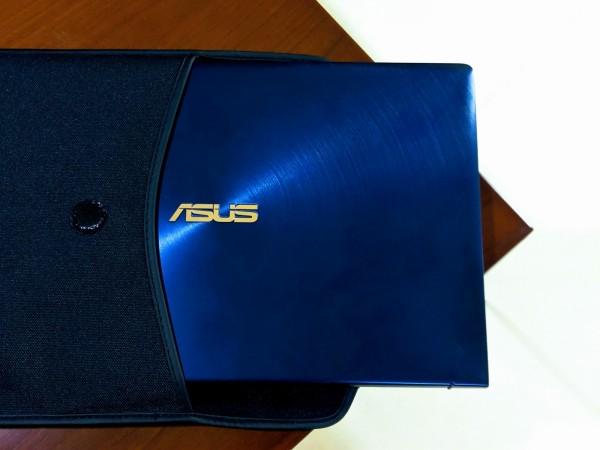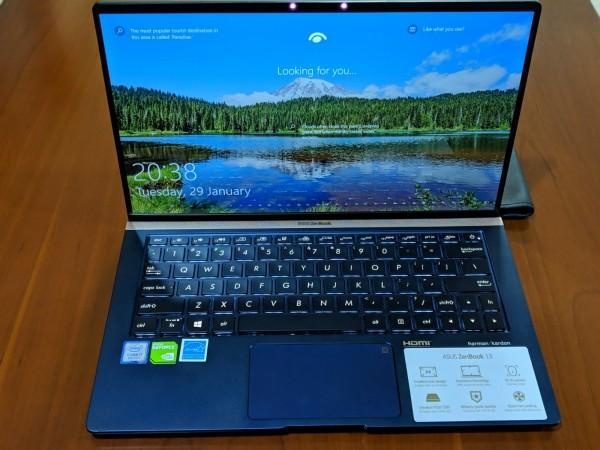
Asus launched its refreshed lineup of Zenbook-series laptops in India on Wednesday, bringing a slew of options to consumers looking to purchase a new notebook this year. Packed with power and designed to impress, the all-new Zenbook-series is out to reignite your love for laptops in trying times.
Asus Zenbook-series comprise of Zenbook 13, Zenbook 14 and Zenbook 15 models, ranging between Rs 71,990 and Rs 1,39,990 depending on the model and specifications. These new notebooks position themselves against the likes of Apple MacBooks and Dell's XPS-series. But the question is should you buy one of the new Zenbooks?
We received the smallest Zenbook – the Zenbook 13 – for review and after briefly spending time with it, here are our initial impressions of the machine.
Look and feel
The overall design factor of Zenbook 13 is compact, making its way straight into the hearts of those who travel with their laptops and work on-the-go. For me, the Zenbook 13 came in extremely handy, be it working remotely on a flight, out of a café or simply browsing through social networking sites or watching cat videos on YouTube.

Asus Zenbook 13 has a fine and premium touch feel factor, which many of you are going to love. The brushed metallic texture on the top with Asus logo is kept minimalistic and elegant. But the real magic is when you open the laptop, which I will talk about later.
Carrying the Zenbook 13 around doesn't pose any challenges, in fact, it is one of the handiest ones out there. It certainly didn't match the comfort levels of carrying my MacBook Air 13, but it certainly doesn't fall on the negative side here. Weighing a little over a kilogram makes Zenbook 13 slightly heavy, but you won't feel the weight in your backpack. I love the overall ergonomics in the design space, complete with its sleekness, positioning of all the ports, speakers, and cooling vents.

If looks matter to you, Asus Zenbook 13 isn't going to disappoint you.
Display that impressive!
As I had mentioned about the magic a while back, all eyes come down to the display and stay there in the Zenbook 13. The frameless design with NanoEdge display with slim bezels makes for one of the best displays in a laptop. The Zenbook 13 has a screen-to-body ratio of 95 percent on a 13.3-inch Full HD display with 72 percent NTSC color gamut and 178-degree wide field view. In short, you are going to love the display on Asus Zenbook 13. The slimmer bezels make the display appear bigger than it actually is and ideal for watching movies and videos.

Diving little deeper into the display, the colours appeared warm, but had good viewing angles. I was not too happy with the reflective display in well-lit areas like working in the outdoor areas of Starbucks. Finding the right angle and adjusting the brightness of the screen certainly helped in my case.

While I used the Zenbook 13 for both work and recreation, I found it to deliver greatly on both fronts. From watching my favourite TV shows to writing articles while on-the-go is a breeze.
Designed for masses
I didn't necessarily need a laptop table to use the Zenbook 13, as it would comfortably fit on my lap as I worked for hours. Asus took an innovative approach to eliminate the dedicated numerical pad on the right and placed in right in the trackpad. I didn't necessarily rely on the new number pad on the touchpad being a MacBook user, but I loved how Asus went the extra mile to make sure its users are not missing out on anything.

The keys on the keyboard are well spaced out, which contributed to comfortable and error-free typing. The keyboard offer silent keystrokes, which is one of the things I love about MacBooks and now Asus has aced it.
One other thing I noticed in the Zenbook 13 is the ease with which it opens with a single finger. The hinges are smooth and slightly lifts the base of the laptop when opened. The bottom bezel of the display is well hidden by design and the gold-hued strip along the keyboard's top area is a nice touch.

The backlit keyboard is as good as it can be. The three-level adjustable keyboard backlight option is certainly a boon, especially when you want to work in a dark room with minimal impact on your eyes.
Moving on, the Zenbook 13 has all the necessary ports you'll need. There's a USB Type C 3.1 port, a USB Type-A port, USB 2.0 port, HDMI port, microSD card lot and an audio jack. Despite offering the Type-C port, the Zenbook uses a traditional DC connector. I certainly wished for Type-C charging, but there's room for improvement here.

Security and ease of access
While setting up the Zenbook 13, I was presented with all the important security options to keep the data safe. Starting with a laptop password to enabling facial unlock using Windows Hello with 3D IR HD camera and a numerical PIN, I never ran out of options. But the most used login method for me on the Zenbook 13 was the face unlock, which worked with utmost accuracy and speed.

The Zenbook 13 relies on Windows Defender for protection against all web-based security threats. Users will need additional anti-virus software for added protection from virus and malware.
Battery that lasts
I was sceptical about the Zenbook 13's battery life, given its compact design, but I was surprised by the results. With continuous mixed use, I was able to get up to 8-9 hours of battery life on the Zenbook 13, which is an impressive feat for a laptop its size. But my concern is with the charging speed, which took almost two hours, sometimes more, to fully charge the laptop. That's not a deal breaker, but Asus could have offered the extra incentive for its users.

Sound
Considering I mostly used headphones while watching movies or TV shows on Zenbook 13, I didn't feel the need for extra-loud stereos. But when work demanded I listen to videos while I'm without my headphones, I felt the sound could be louder. The audio seems well balanced and Asus focused on quality rather than loudness in the Zenbook 13. I'm not complaining of this, as users can easily use the headphone jack or connect their wireless headphones to compensate for the stereos.
Performance
Finally, coming down the performance, my brief time with the Zenbook 13 did not allow me to do a stress test, but I was not disappointed by what I saw. As a primary daily driver, Zenbook 13 certainly packs more power than necessary. Using online web clients or installed apps did not render any lags or crashes at any given time. But I'm not too sure of how well it can handle heavy tasks such as video rendering, so I will reserve my final verdict for the full review.
The review unit I tested was equipped with 8GB LPDDR3 RAM, 512GB PCle 3.0 x2 SSD, dual-band 802.11ac Wi-Fi, Bluetooth 5.0 and Windows 10 among other standard features. The connectivity was decent at its best.
Asus Zenbook 13's performance is made for the working class masses in India.















